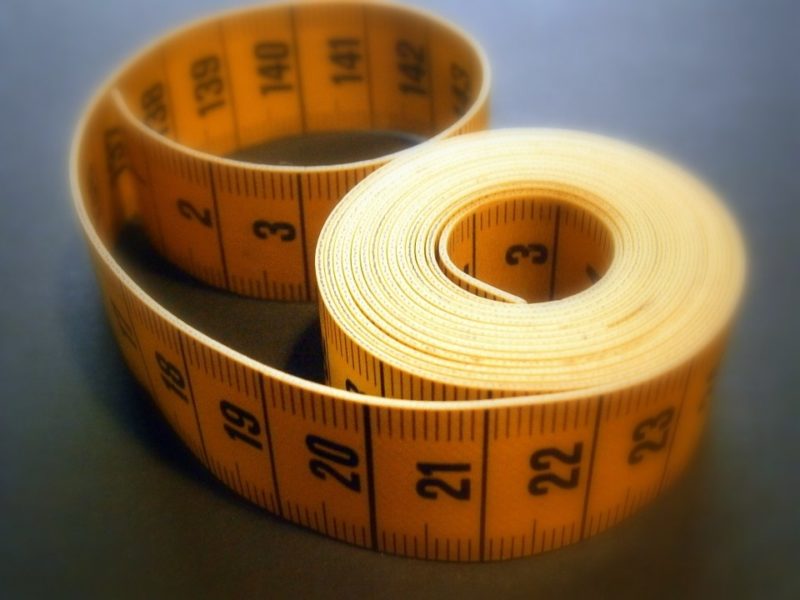If you want to find out what is my wedding dress size, please consider these two steps beforehand. Brides tend to freak out since most shops offer wedding dress sizes that run too small.
However, the measurements for these wedding gowns can still be altered, and it’s expected that you will be on a different bridal sizing than what you’ll usually get for other clothes. For additional reference, check how to measure for a wedding dress after this read.

What Is My Wedding Dress Size: Bridal Sizing Guide
Step 1. Get an idea of your sizes
Have someone help you find the perfect wedding dress size by measuring your bust, waist, and hips before going to the bridal shop. Wrap a measuring tape around these regions, snug but not too tight that it cinches the skin.
Remember that your bust is the fullest part of the chest, the waist is the creasing area when you bend to the side, and the hips are around the fullest part of your buttocks. Keep your posture straight with your legs together, and have someone jot down the numbers.
And since you measure for wedding gowns, it would also help to take the hollow to hem to know how long the dress will go. Place the measuring tape from the base of your neck or collarbone to your feet or according to the height you want for the dress, especially if you’re showing your bridal shoes.
Step 2. Compare with the store’s dress sizing for wedding dress alterations
After you have your bust, waist, and hips measurements, you can bring them to the bridal shop to compare with the store’s wedding dress sizing. Designers and boutiques vary in size, so you might be a specific size to one shop but “bigger” or “smaller” to another.
Below is an example of wedding dress sizes 2 to 8 used in some bridal shops. But regardless, knowing your bust, waist, and hips is crucial since you might fall in various dress sizes per shop.
- Size 2: bust-32.5 in, waist-25.5 in, hips- 35 ¾ in
- Size 4: bust-33.5 in, waist-26.5 in, hips- 36 ¾ in
- Size 6: bust-34.5 in, waist-27.5 in, hips- 37 ¾ in
- Size 8: bust 35.5 in, waist-28.5 in, hips- 37 ¾ in
As you go through multiple wedding dress boutiques to compare gowns, you will also discover what dress areas typically need alterations to fit your body type perfectly. Remember that it’s normal to have different proportions from the “standard” body type, and don’t freak out or feel bad if you need alterations or unique sizes for your wedding dress.
Are Wedding Dresses True To Size?
Bridal dress sizes are different from regular or standard sizing for other dresses and typically streetwear. So even if, for example, you usually get a size 8 dress, you may find the shop’s size 8 bridal gown too small for you.
You must bring your bust, waist, and hips measurements to compare to the boutique’s size chart. The shop also has an expert to help you find the ideal size, and you can consult their seamstress to know where you want changes, alterations, and modifications on the wedding dress.
Tips to get the perfect fitting wedding dress:
Do not stress and worry about not finding your wedding dress size. You can remember these tips instead to avoid any headaches during dress shopping:
- Measure your bust, waist, and hips with help from a friend to ensure that the tape is snug against these regions
- Ask for the size chart of the designer and compare, especially when ordering online; when in doubt, order the larger wedding dress size because it can be altered
- Ideally, visit the bridal shop to try different styles and sizes of the boutique’s wedding dresses; someone will also help you with the fittings and measurements if you shop for dresses in person
Read about wedding dress shopping etiquette to prepare for your fittings.
Why Do Wedding Gown Sizes Run So Small?
Bridal dress sizes run smaller than regular sizing because it’s more common for wedding gowns to be custom-made. In addition, since wedding dresses are made-to-order, the offered sizes in the shops are not as many and more limited than ready-to-wear clothes in inclusive sizes.
There is also no standard or set rules for bridal sizing. One shop may offer different measurements for a specific size, so you can’t use one store as a reference when wedding dress shopping.
And finally, consider how each shop or designer makes their wedding dresses. If the brand is known to mass produce, you may find more size options than shops that only make custom dresses.
What Is A Split-Size Wedding Dress?
Some bridal shops and designers offer a so-called “split sizing” for a fee. For example, you may fit a size 6 based on their chart, but the hip would be too big for your body type.
It is called split size because the shop will offer alteration for that area, so you fit the size 6 perfectly.
Conclusion
And that’s it! You just learned what is my wedding dress size by getting your bust, waist, and hip measurements first.
Then compare them to the size chart of each designer and bridal shop. You can also order a slightly bigger wedding dress for alterations.
